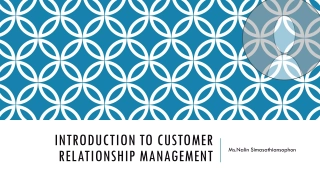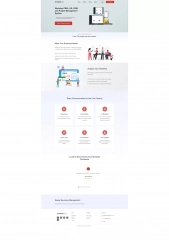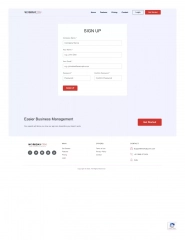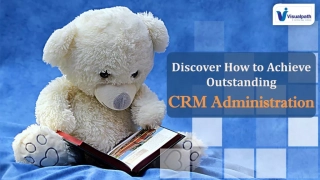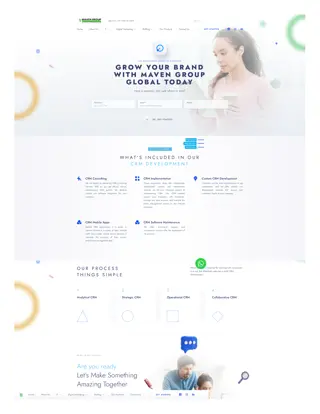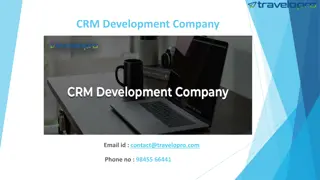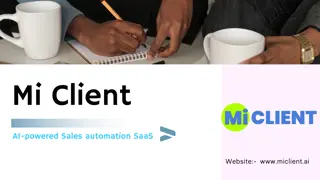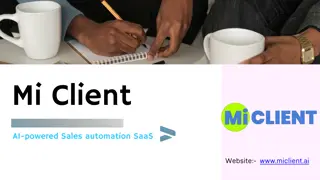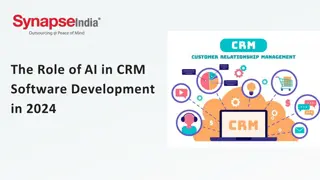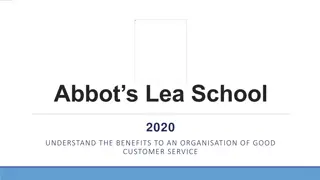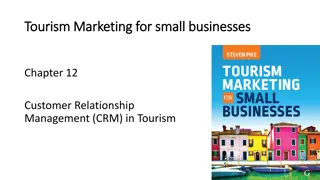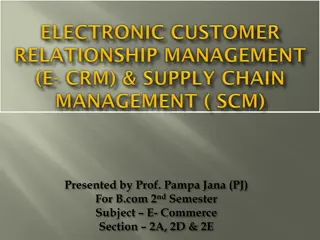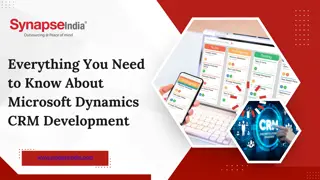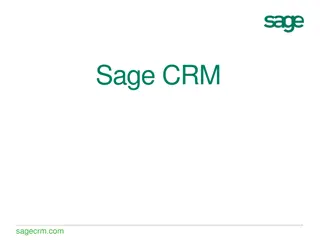Customer Relationship Management (CRM)
Customer Relationship Management (CRM) is crucial for businesses to build and maintain relationships with their customers. It involves collecting and analyzing customer data, implementing strategies to meet their needs, and fostering long-term relationships. CRM benefits both businesses and customers by improving service, enhancing relationships, and increasing customer involvement. The key focus is on understanding the evolving nature of customer relationships, segmentation based on profitability, and providing better service.
Download Presentation

Please find below an Image/Link to download the presentation.
The content on the website is provided AS IS for your information and personal use only. It may not be sold, licensed, or shared on other websites without obtaining consent from the author.If you encounter any issues during the download, it is possible that the publisher has removed the file from their server.
You are allowed to download the files provided on this website for personal or commercial use, subject to the condition that they are used lawfully. All files are the property of their respective owners.
The content on the website is provided AS IS for your information and personal use only. It may not be sold, licensed, or shared on other websites without obtaining consent from the author.
E N D
Presentation Transcript
Module 1 INTRODUCTION AND BENEFITS OF CRM Sem - 5
Who is the king of market? Ans :- CUSTOMER
Ans:- Someone who buys GOODS or SERVICES. Who is customer
1.External 2.Internal There are mainly two types of customers
Categories of customers
A set of best practices is emerging that focus on measuring and increasing the lifetime value of the customer base, one customer at a time. We call these practices as Customer Relasionship Management Eg: Basic Database of customers , Social CRM like facebook , Email etc. Introduction to crm THE CRM COMRISES OF 1. A database that collects information 2. A way to analyze the information in the database 3. A strategy for applying the analysis to identify and meet need of clients 4. Collecting data to ensure business strategy is effective.
Customer Relasionship management is a comprehensive set of process and technologies for managing the Relasionship with potential customer across the business functions. Definition Of Crm In Simple words: CRM is a comprehensive approach for creating maintaining and expanding customer relationships.
1. A Central Database 2. Anlysis of customer data Features of CRM 3. Customer self service 4. Identifying and tracking potential Customers 5. Generating updated reports
1. CUSTOMER AS STRANGERS Evolution of Relasionship with Customers 2. CUSTOMER AS ACQUAINTANCES 3. CUSTOMER AS FRIENDS 4. CUSTOMER AS PARTNERS
Segmentation of customer as per profitability
1. Better service 2. Improved Relasionship Benefits of CRM to Customers 3. Social Relationship 4. Involvement in process
1. Identification of potential Customers 2. Increase Profitability 3. Decrease operating cost 4. Increased Customer Loyalty 5. Improved Customer Satisfaction 6. Other benefits Benefits of CRM to Organizations Know History of customer Easily assess to collected data Tracking and monitoring of Customers Increase of cross selling and up selling
Benefits of Implementing CRM system as per functional area 1. Marketing 2. Customer Support 3. Sales
1. Focused on retention of existing customers Disadvantages of CRM 2. Ethical and privacy issues 3. Discrimination (More profitable customers will be given more preferences and vice- versa).
1. Operational CRM 2. Analytical CRM 3. Sales Intelligence CRM 4. Campaign Mangement Types of CRM 5. Collaborative CRM 6. Geographic CRM 7. Strategic CRM
1. Providing Expected services 2. Offering better customer service Objectives of CRM 3. Attracting new customers 4. Lower level of operating cost 5. Aiding the Marketing Department
Components of CRM
1. Wrong Implementation 2. Lack of commitment 3. Quality of Data Barriers to CRM 4. Resistance to Change 5. Unclear Objectives 6. Work Stress
Framework for deploying value of CRM in an organization(organisation pervasive approach) Five S s is a format used by management consultant to relate organisational characteristics and capability to the CRM implementation strategy.
SERVICE LEVEL AGREEMENT 1.Overall objectives 2.Description of the services 3.Performance Standards 4.Compensation/ Service credits 5.Critical Failures
There are six steps to the SLA process map. Step l: Decide the objective of CRM strategy. Step 2: Meet with the other party to define require and expectations. Step 3: Defined performance measures. Step 4: Define rewards and penalties. Step 5: monitor performance. Step 6: To review the SLA regularly.
Brand Awareness Brand Loyalty Brand Building through relationship marketing Brand Association Perceived quality
1.Create Emotional Bond 2.Up to mark Expectations 3.Managing customer Emotions will come in recent years Managing Customer Emotions
No creation of new customer Cant predetermine a set of marketing Measuring return on investment is difficult Require Huge Funds Relationship Challenges Not possible to use electronic means for all organisation Right kind of technology should be used Selection of proper CRM Manager is also a challenge.
SEVEN C'S OF CRM C1: Convenience C2: Customer value and benefit C3: Cost to the customer C4: Computing and category management 7 C s of CRM C5: Customer franchise C6: Customer care and service C7: Communication and customer relationships.








